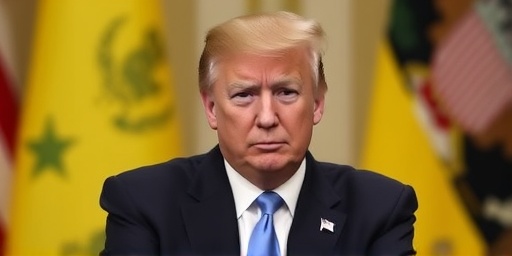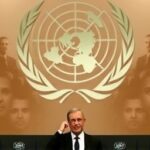In a bold move that’s rippling through global diplomacy, President Donald Trump has issued a Thursday deadline for Ukraine to respond to a US-backed peace proposal aimed at ending the protracted conflict with Russia. Speaking from the White House, Trump emphasized that while the timeline is firm, extensions could be granted if meaningful progress emerges in ongoing negotiations, spotlighting the fragile state of international efforts to broker peace.
Trump‘s Ultimatum Ignites Fresh Urgency in Ukraine Conflict
The announcement came during a press briefing where Trump, flanked by key advisors, underscored the need for swift action to prevent further escalation. “We’ve put forward a solid peace proposal, backed by the United States, and Ukraine has until next Thursday to give us their answer,” Trump stated, his tone a mix of impatience and optimism. This deadline, set for just over a week from the announcement, has injected a sense of immediacy into talks that have dragged on for months amid battlefield stalemates and economic strains.
The Ukraine conflict, now entering its third year since Russia’s full-scale invasion in February 2022, has claimed over 500,000 lives according to United Nations estimates, displaced millions, and triggered a global energy crisis. Trump’s intervention marks a pivotal moment, as the US has ramped up its role in mediation following stalled European Union-led initiatives. Sources close to the administration reveal that the peace proposal was crafted in collaboration with allies, incorporating elements like territorial concessions, security guarantees, and economic aid packages totaling $50 billion from international donors.
Trump’s approach reflects his signature deal-making style, often prioritizing deadlines to force concessions. During his first term, similar tactics were employed in Middle East peace accords, yielding mixed results but demonstrating his willingness to leverage US influence. Critics, however, warn that such pressure on Ukraine could undermine its sovereignty, especially as President Volodymyr Zelenskyy grapples with domestic fatigue over the war’s toll.
Unpacking the Core Elements of the US-Backed Peace Proposal
At the heart of the negotiations lies the US-backed peace proposal, a multifaceted document designed to address the root causes of the conflict while ensuring long-term stability. Key components include a proposed ceasefire along current frontlines, which would recognize Russian control over Crimea and parts of Donbas—territories Moscow annexed or seized in 2014 and 2022. In exchange, Ukraine would receive ironclad NATO membership pathways and billions in reconstruction funds.
Diplomatic insiders describe the proposal as a “balanced compromise,” drawing from previous Minsk agreements that failed to hold. “This isn’t just about stopping the guns; it’s about rebuilding a nation,” said a senior State Department official, speaking anonymously. The plan also mandates the demilitarization of a 50-kilometer buffer zone along the border, monitored by UN peacekeepers, to prevent future incursions.
Economic incentives form a cornerstone, with the US pledging $20 billion in direct aid, supplemented by contributions from the EU and Japan. Statistics from the World Bank highlight the devastation: Ukraine’s GDP has shrunk by 30% since the invasion, with agricultural exports—once 10% of the global supply—halved due to disrupted Black Sea routes. The peace proposal includes lifting sanctions on Russia in phases, tied to verifiable troop withdrawals, aiming to stabilize global food prices that spiked 20% last year.
Security assurances are equally critical. The document outlines a 10-year defense pact with the US and NATO, providing advanced weaponry and intelligence sharing without immediate full membership, which Russia views as a red line. Zelenskyy has publicly praised aspects of the proposal but insisted on retaining full territorial integrity, a stance that complicates the deadline’s feasibility.
Ukraine’s Leadership Faces Internal and External Pressures
In Kyiv, the deadline has sparked intense debate within Ukraine’s government and among its citizens weary of war. President Zelenskyy, who rose to prominence as a wartime leader, convened emergency cabinet meetings following Trump’s announcement. “We appreciate the US support, but any peace must honor Ukraine’s right to exist as a sovereign state,” Zelenskyy told reporters, echoing sentiments from a recent poll by the Kyiv International Institute of Sociology showing 62% of Ukrainians oppose territorial concessions.
Domestic challenges compound the external pressure. Inflation in Ukraine hovers at 25%, and blackouts from Russian strikes on infrastructure affect 40% of the population daily. Military recruitment has faltered, with desertion rates up 15% according to defense ministry leaks. Zelenskyy’s administration is balancing these realities with alliance dependencies—the US has provided $75 billion in aid since 2022, making Trump’s deadline a high-stakes gamble.
Opposition voices within Ukraine, including former Prime Minister Arseniy Yatsenyuk, argue for cautious engagement. “Rushing into this peace proposal risks betraying our sacrifices,” Yatsenyuk warned in an op-ed. Meanwhile, public protests in Kyiv and Lviv demand transparency, with organizers citing the need for parliamentary approval before any response to the deadline.
Internationally, allies like Germany and France have urged flexibility. Chancellor Olaf Scholz, in a joint statement with French President Emmanuel Macron, called the proposal “a foundation for dialogue,” while committing €10 billion more in humanitarian aid. This support underscores the interconnected stakes: a prolonged conflict could exacerbate Europe’s migrant crisis, already swelling with 6 million Ukrainian refugees.
Global Powers React to Trump’s Negotiation Timeline
Trump’s deadline has elicited a spectrum of reactions from world leaders, amplifying the geopolitical tensions surrounding Ukraine. Russian President Vladimir Putin dismissed the proposal as “American meddling,” but Kremlin sources indicate quiet interest in the territorial recognitions, potentially opening a backchannel for talks. In a rare interview with state media, Putin noted, “If the West is serious about peace, they must respect realities on the ground,” hinting at willingness to negotiate if the deadline passes without escalation.
China, a key Russian ally, has positioned itself as a neutral broker. Beijing’s foreign ministry praised the US initiative but stressed multilateral involvement, recalling its own 12-point peace plan from 2023 that emphasized sovereignty without specifics. Trade data shows China’s imports of Russian oil surged 25% amid sanctions, giving it leverage to influence Moscow’s stance.
In the Middle East, Saudi Arabia and the UAE—hosts to recent US-Russia dialogues—offered to mediate, leveraging their neutral status. “The deadline could be a catalyst if all parties commit,” said UAE Foreign Minister Abdullah bin Zayed in a tweet. Meanwhile, the UN Security Council scheduled an emergency session, where Secretary-General Antonio Guterres warned of “catastrophic” consequences if negotiations falter, citing 10 million people at risk of famine in Ukraine and neighboring regions.
US domestic reactions are polarized. Republican senators like Lindsey Graham hailed Trump’s move as “decisive leadership,” while Democrats, including Senate Majority Leader Chuck Schumer, criticized it as “reckless pressure on an ally under siege.” Polling from Pew Research indicates 55% of Americans support ending US involvement in Ukraine, influencing the administration’s aggressive timeline.
Expert analyses from think tanks like the Brookings Institution suggest the deadline could accelerate a frozen conflict scenario, similar to Korea’s divide. “Trump’s strategy bets on momentum; if Ukraine balks, it risks isolating itself,” noted analyst Fiona Hill in a recent report. Financial markets reacted swiftly, with European gas prices dipping 5% on hopes of de-escalation, per Bloomberg data.
Navigating the Path Ahead: Extensions, Risks, and Opportunities
As the Thursday deadline looms, the trajectory of negotiations hinges on Ukraine’s response and the flexibility Trump promised. Administration officials have signaled readiness to extend if preliminary talks yield concessions, potentially pushing the timeline to mid-November. This adaptability could foster incremental progress, such as localized ceasefires in Kherson or Zaporizhzhia, where fighting has intensified recently.
Yet risks abound. A rejection by Ukraine might prompt Russia to launch winter offensives, exploiting frozen terrain as in past campaigns. Intelligence reports from NATO estimate Russian forces at 500,000, bolstered by North Korean munitions supplies. Conversely, acceptance could unlock a cascade of diplomatic wins: renewed Black Sea grain exports, easing global food insecurity affecting 2.4 billion people per FAO figures.
Long-term, the peace proposal’s success depends on enforcement mechanisms. Proposed UN-led verification teams, numbering 20,000 personnel, would monitor compliance, drawing lessons from Bosnia’s peacekeeping model. Economic recovery plans envision Ukraine rejoining EU trade blocs by 2027, boosting its $200 billion economy.
Stakeholders eye upcoming summits, including the G20 in Brazil, as venues for breakthroughs. Trump’s team is preparing contingency scenarios, from intensified sanctions to direct US-Russia summits. For Ukraine, the deadline represents not just a test of resolve but a chance to pivot from survival to rebuilding, potentially reshaping Europe’s security landscape for decades.
In the broader context, this moment underscores the US’s enduring role in global conflicts. As negotiations unfold, the world watches whether Trump’s deadline will forge peace or fracture alliances further, with implications rippling from Kyiv’s streets to Wall Street’s trading floors.









